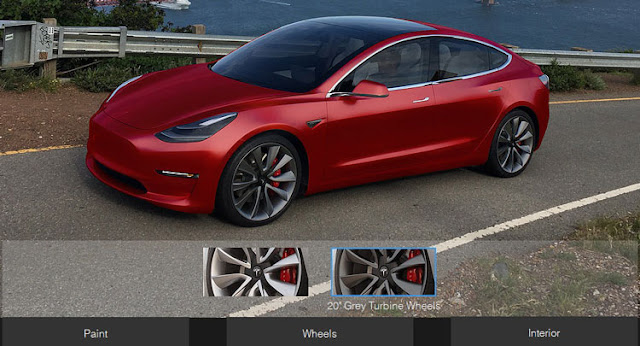At the recent shareholders meeting
Elon Musk
did some announcements and clarifications about current and future products, but the most important of them is about the Model 3. Production is about to begin any day now (initially only for Tesla and Space X employees), then by the end of July reservation holders will get an e-mail with an invite to configure their Model 3.
The configurator will look like this, probably without the interior options. Elon didn't state it definitively, but suggested that you'll be able to choose wheel size (18" or 19") and body color, that's it. All the other options will be the a combination of the most frequently requested and easiest to manufacture.
What we already know for sure, is that the first batch of Model 3s will come with the largest battery pack and rear wheel drive. It's not clear yet whether they'll push for all glass roof, or go with the simple metal roof. It will probably depend on the supplier's performance, assuming they are not making it in-house, yet.
Elon joked about the first batch of Model S, which had no options at all, you just ordered "one Model S". It also came with the largest, 85kWh battery pack (probably for value and proof of range) and only rear wheel drive. Later they added more complexity with the Performance (P85) option, which meant you'll get a less efficient, but a lot faster/larger motor and more aggressive electronics/settings. Then they added a second motor in the front for all-wheel-drive and more efficiency on highways and in city traffic...and so on...
About the battery pack we know that the smaller space under the Model 3 allows for 75kWh max. with current Li-ion technology (2170
Gigafactory
cells), so that's what customers are hoping for, but it might be less than that, like 70kWh in the first year of production. Don't get me wrong, that is still a lot of energy. For comparison the Chevy Bolt EV has a 60kWh battery pack and has a 230+ mile range. These first Model 3s will most likely exceed that - if I had to guess, I'd say they'll have a 250+ mile EPA rating.
The Chevy Bolt EV uses a permanent magnet motor, which requires rare earth metals (not too ECO friendly), but offers very good regen braking. Tesla uses 3-phase induction motors with a copper rotor, which makes them more environmentally friendly and completely recyclable, but have a slightly less efficient regen braking, as the motor requires some power to generate the - otherwise absent - magnetic field.
The Model 3 motors will most likely have less performance than Model S and X motors, but the durability target is 1,000,000 miles with minimal maintenance (lubrication oil change every 1-2 years or 50.000-100.000 miles).
Model 3
will eventually come with all-wheel-drive option in late 2017 or early 2018. To be clear, early production Model 3s will not be upgradable to dual motor AWD. If you'll want AWD you can return your Model 3 to Tesla for a fair price and order a new Model 3 with the additional options you need.
Please visit
Tesla's website for more information.



























